Oncocytic Renal Neoplasm: A Comprehensive Overview
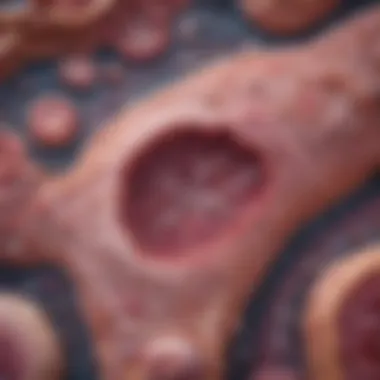

Intro
Oncocytic renal neoplasms represent a distinct category of tumors that arise in the kidney, characterized by their unique histological features. These tumors are often overlooked due to their relatively niche status within renal pathology. Despite their rarity, oncocytic renal neoplasms exhibit significant clinical implications and diagnostic challenges, making an exploration of this topic essential for healthcare professionals, researchers, and students alike.
Understanding these neoplasms requires a comprehensive look at their histological characteristics, biological behavior, and treatment options. This exploration serves to bridge the gap in knowledge surrounding these tumors, which may aid in their identification and management in clinical settings.
Additionally, we will analyze the role of advanced imaging techniques, providing context for their benefits and limitations in diagnosing these neoplasms. By examining recent research trends, we aim to highlight the evolving understanding of oncocytic renal tumors, underscoring the importance of ongoing studies in this area.
Preamble to Oncocytic Renal Neoplasm
The exploration of oncocytic renal neoplasms offers significant insights into a niche yet critical area of renal pathology. Oncocytic tumors are characterized by distinct histopathological features that often complicate their diagnosis and treatment. This article aims to illuminate these unique aspects and address the clinical implications associated with such neoplasms. Understanding oncocytic renal neoplasms is essential for both researchers and clinicians, as it directly influences patient management and outcomes.
Definition and Background
Oncocytic renal neoplasm refers to a group of kidney tumors that are primarily composed of oncocytes, which are large kidney cells that have an abundance of mitochondria. These tumors can occur in a variety of forms, including oncocytomas and chromophobe renal cell carcinomas. The term "oncocytic" stems from the presence of oncocytes, which can be identified through specific histological staining techniques. These tumors tend to be benign but have the potential for malignant transformation, rendering their classification and management complex.
The characterization of oncocytic renal neoplasms is not just of academic interest but also has clinical ramifications. The histological uniqueness of these tumors can lead to various diagnostic challenges, often requiring expert pathological insights for accurate diagnosis. Furthermore, understanding the biological behavior of oncocytic tumors can guide clinicians in determining appropriate treatment strategies.
Historical Context
The study of oncocytic renal neoplasms has evolved significantly over the years. Initially, oncocytomas were considered atypical renal neoplasms with limited understanding of their biological implications. Early research focused predominantly on their benign nature, with many cases managed conservatively. However, as advancements in imaging and biopsy techniques emerged, the complexity surrounding these tumors became more pronounced.
Historic milestones in the recognition and classification of oncocytic tumors have revealed the nuanced differences between them and other renal neoplasms, such as clear cell carcinoma and papillary renal cell carcinoma. This new understanding has paved the way for ongoing research and has fostered a more comprehensive dialogue within the medical community. Healthcare professionals who engage with oncocytic tumors must appreciate this historical context, as it informs current diagnostic approaches and treatment modalities.
"Understanding the historical context of oncocytic renal neoplasms is crucial as it shapes today's clinical practices and future research directions."
"Understanding the historical context of oncocytic renal neoplasms is crucial as it shapes today's clinical practices and future research directions."
In sum, a deeper comprehension of oncocytic renal neoplasms enhances the overall landscape of renal pathology, guiding both current clinical practice and future research efforts.
Histopathological Characteristics
The histopathological characteristics of oncocytic renal neoplasm are critical for understanding its behavior and distinguishing it from other renal tumors. These features play a vital role in making a correct diagnosis, managing treatment, and predicting outcomes. Knowing the cellular composition, microscopic features, and differential diagnosis allows clinicians and pathologists to provide better care for patients.
Cellular Composition
Oncocytic renal neoplasms are recognized by their distinct cellular makeup. They are primarily composed of oncocytes, which are renal epithelial cells characterized by their abundant eosinophilic (pink-staining) cytoplasm. This pinkish appearance results from excessive mitochondria within the cells. These tumors are also often seen in areas of the kidney that are subject to chronic injury or inflammation.
The specific composition can indicate various prognostic outcomes. For example, the nuclear characteristics, such as pleomorphism and nuclear size, can suggest more aggressive behavior. Current research continues to explore how different cellular compositions might correlate with patient prognoses.
Microscopic Features
Microscopically, oncocytic neoplasms display unique architectural patterns. They may demonstrate a solid, trabecular, or even nested arrangement. The nuclei within these oncocytes can vary in size and shape. A prominent feature is the presence of a central nucleus with a clear halo surrounding it. This characteristic can often help pathologists distinguish oncocytic tumors from other neoplasms, such as chromophobe renal cell carcinoma.
Moreover, the presence of clear cells or foamy macrophages can further complicate the microscopic assessment. Pathologists frequently encounter necrotic areas and sometimes lymphocytic infiltrate in oncocytic tumors, indicating possible immune responses or secondary inflammatory processes.
Differential Diagnosis
Differential diagnosis is crucial when evaluating oncocytic renal neoplasms. They can be easily misdiagnosed as other types of tumors due to overlapping features. The main neoplasms to consider in differential diagnosis include clear cell carcinoma and chromophobe renal cell carcinoma.
- Clear Cell Carcinoma: Presents with clear cells due to glycogen and lipid accumulation, often requiring careful examination to differentiate from oncocytic tumors.
- Chromophobe Renal Cell Carcinoma: Shares some similarities in cellular composition, but with characteristic perinuclear halos and different growth patterns.
Pathologists utilize immunohistochemical stains to aid in the differentiation process. Specific markers, such as PAX8, CD10, and Alpha-methylacyl-CoA racemase, play key roles in elucidating the distinct nature of oncocytic tumors.
By understanding these histopathological characteristics, healthcare professionals can significantly improve diagnostic accuracy and treatment pathways for patients with oncocytic renal neoplasms.
By understanding these histopathological characteristics, healthcare professionals can significantly improve diagnostic accuracy and treatment pathways for patients with oncocytic renal neoplasms.
Clinical Implications
Understanding the clinical implications of oncocytic renal neoplasms is crucial for both diagnosis and treatment. The relevance of this area cannot be overstated, as it encompasses patient outcomes, management strategies, and overall healthcare approaches for those affected by these tumors. Specifically, several key elements require careful consideration.
Oncocytic renal neoplasms, often defined by their unique histopathological characteristics, can present significant diagnostic challenges. Knowledge of their epidemiology and symptomatology informs effective clinical practices. This understanding enhances the ability to differentiate these neoplasms from other renal tumors, which can be critical for appropriate patient management.
Epidemiology
Epidemiology plays a central role in the clinical implications of oncocytic renal neoplasms. These tumors predominantly occur in adults, typically in individuals over the age of 50. They represent a minority among renal tumors but have gained attention given their unique clinical behavior. Factors such as gender, ethnicity, and geographic region can influence the incidence rates. While data on oncocytic tumors specifically is limited, research indicates that oncocytomas are more frequently diagnosed in male patients.
- The reported prevalence of oncocytomas ranges from 3% to 7% of all renal tumors.
- Higher rates of these tumors have been observed in specific backgrounds, suggesting environmental or genetic factors may be at play.
- There is also ongoing investigation into the links between oncocytic neoplasms and conditions such as tuberous sclerosis complex, emphasizing the need for further research in this area.
Awareness of these epidemiological trends is essential for healthcare providers, allowing for proactive screening in high-risk populations and better resource allocation.
Symptoms and Presentation
The clinical presentation of oncocytic renal neoplasms can vary, which underscores the importance of understanding the symptoms associated with these tumors. Many patients may be asymptomatic, leading to incidental findings during imaging studies performed for unrelated issues. However, when symptoms do occur, they can include:
- Hematuria
- Flank pain
- A palpable mass in the abdomen
- Weight loss
- General malaise
As oncocytic neoplasms progress, these symptoms can become more pronounced. Identifying such symptoms early can facilitate timely diagnosis and intervention. The subtlety of initial presentations can sometimes lead to delays in diagnosis, emphasizing the need for awareness among both patients and clinicians about potential signs of renal tumors.
In essence, a comprehensive understanding of epidemiology and symptoms helps inform clinicians who encounter patients presenting with renal masses. This knowledge not only aids in providing timely care but also enhances survival rates and improves quality of life for patients diagnosed with oncocytic renal neoplasms.
Diagnostic Approaches
Diagnostic approaches for oncocytic renal neoplasms play a crucial role in the accurate identification and management of these tumors. Understanding these approaches encompasses various methods including imaging techniques and biopsy procedures, which are essential for clinicians. These diagnostic tools not only aid in confirming the presence of oncocytic tumors but also provide valuable insights into their characteristics, which is vital for determining effective treatment plans.
Imaging Techniques
Imaging techniques serve as the first line of investigation when suspecting oncocytic renal neoplasms. Each modality offers unique contributions, shaping the diagnostic pathway.
Ultrasound
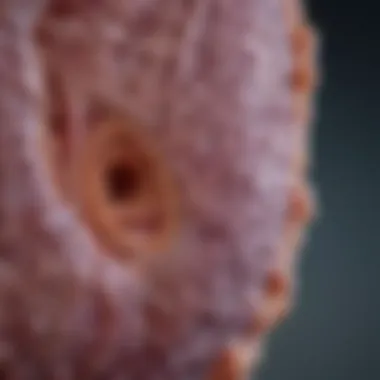

Ultrasound is a non-invasive imaging technique that uses sound waves to create images of the kidneys. One key characteristic of ultrasound is its ability to visualize renal masses without exposing patients to radiation. This aspect makes it a beneficial option for initial evaluations, especially in patients who are vulnerable or require repeated assessments.
The unique feature of ultrasound is its real-time imaging capability, which allows for immediate assessment of renal lesions in terms of size and morphology. However, its limitations include lower specificity compared to other imaging modalities, meaning it may not differentiate between oncocytic tumors and other types of lesions effectively.
CT Scan
Computed tomography (CT) scans are another essential imaging modality for oncocytic renal neoplasms. The high-resolution images produced offer detailed cross-sectional views of the kidney and surrounding tissues. This characteristic is crucial when attempting to assess tumor extension or any potential metastasis.
CT scans are widely recognized for their ability to provide both anatomical and functional insights. However, they do involve exposure to ionizing radiation, which presents a risk in certain populations. Additionally, contrast material used in certain CT protocols may pose challenges in patients with renal impairment.
MRI
Magnetic Resonance Imaging (MRI) is increasingly used in the diagnostic evaluation of oncocytic renal neoplasms, offering high contrast resolution of soft tissues. This feature allows for better differentiation of tumor types based on their biological characteristics.
One significant advantage of MRI is the absence of ionizing radiation, making it safer for patients who require multiple scans. However, its availability and cost can limit its routine use in some healthcare settings. As for the disadvantages, while MRI provides excellent detail, it may not always be as accessible or quick as CT scans.
Biopsy and Histology
When imaging results indicate the presence of an oncocytic renal neoplasm, further evaluation through biopsy is often necessary. Biopsy allows for histological examination, providing definitive evidence of tumor type. The histological characteristics gleaned from biopsy can guide treatment decisions and help assess prognosis. This step is critical in differentiating oncocytic tumors from other renal neoplasms, ensuring accurate diagnosis.
In summary, the diagnostic approaches for oncocytic renal neoplasms combine various imaging and biopsy techniques. Each method presents unique advantages and certain drawbacks that must be considered. Understanding these approaches is essential for delivering effective care.
Therapeutic Options
Understanding therapeutic options for oncocytic renal neoplasms is crucial for managing this type of tumor effectively. The choice of therapy can significantly influence patient outcomes, including survival and quality of life. Surgical management is often the first step, followed by possible adjuvant therapies to combat any remaining disease. Each option has its benefits and considerations, highlighted by recent advancements in clinical practices.
Surgical Management
Partial Nephrectomy
Partial nephrectomy, which involves the removal of the tumor along with a margin of healthy tissue, is a favored option for localized oncocytic tumors. This approach preserves more of the kidney's function compared to radical nephrectomy. One key characteristic is that it minimizes the risk of chronic kidney disease post-operation. The technique is especially beneficial for patients with smaller tumors or those with a solitary kidney. Moreover, studies suggest that patients who undergo partial nephrectomy tend to have similar oncological outcomes to those undergoing radical nephrectomy, thus supporting its use as a viable first-line option.
However, partial nephrectomy is not without risks. The surgery requires careful tumor selection, as factors such as the tumor's location and size can complicate the procedure. Surgeons must be skilled to avoid excessive bleeding or complications from the incomplete removal of cancerous tissues.
Radical Nephrectomy
Radical nephrectomy involves the complete removal of the affected kidney along with surrounding tissues. Its contribution to the management of oncocytic renal neoplasm is significant, particularly when tumors are large or located in a way that renders partial nephrectomy impractical. A key characteristic of radical nephrectomy is its effectiveness in eliminating all disease and preventing metastasis. This option is often seen as the gold standard for more advanced cases due to its comprehensive approach.
Nevertheless, radical nephrectomy presents unique challenges. While it effectively addresses tumor burden, it can lead to loss of kidney function, especially in patients with pre-existing kidney issues. The need for long-term follow-up and monitoring for recurrence is highlighted, as the complete removal of the kidney does not guarantee absence of disease.
Adjuvant Therapies
Adjuvant therapies are essential for oncocytic renal neoplasms, especially when surgical options are not fully curative. These therapies aim to eliminate residual cancer cells and provide a systemic approach to treatment. Two prominent types are immunotherapy and targeted therapy.
Immunotherapy
Immunotherapy works by stimulating the body’s immune system to recognize and attack cancer cells. This approach is increasingly relevant in the context of oncocytic tumors. A key characteristic is its ability to harness the body's natural defenses, potentially offering a unique path in the treatment of renal neoplasms. Treatments like pembrolizumab and nivolumab have shown promise in recent trials for their efficacy against various cancers, including renal cell carcinoma.
The unique feature of immunotherapy is its relatively favorable side effect profile compared to traditional chemotherapies, making it a good option for many patients. However, response rates can vary, and some patients may experience immune-related side effects that require management.
Targeted Therapy
Targeted therapy focuses on specific molecular targets associated with cancer. In oncocytic renal neoplasms, agents like sunitinib or pazopanib are frequently discussed. These therapies are designed to block the growth of cancer cells by interfering with specific proteins or pathways, making them an attractive option for patients.
A key characteristic of targeted therapy is its specificity, which often results in fewer side effects than traditional chemotherapy. This can lead to improved quality of life for patients. However, the potential for resistance as well as the need for genetic profiling to determine eligibility present challenges in their application.
Prognostic Factors
Prognostic factors play a crucial role in understanding oncocytic renal neoplasms. These elements inform both the likely course and outcome of the disease, guiding treatment decisions and providing essential insights for patients and clinicians alike. The importance of prognostic factors lies in their ability to predict survival rates and overall disease progression. As oncocytic tumors exhibit distinct biological behaviors, recognizing these factors becomes essential for tailoring effective therapeutic strategies.
Tumor Size and Stage
The size and stage of an oncocytic tumor significantly influence the prognosis. Tumor size is generally correlated with the likelihood of metastasis and overall survival. Larger tumors typically present a greater challenge, as they may invade surrounding tissues and exhibit aggressive behavior. Staging provides a framework for assessing the extent of tumor spread, incorporating factors such as lymph node involvement and distant metastasis.
- T1 Stage: Tumors 7 cm, confined to the kidney.
- T2 Stage: Tumors > 7 cm, also confined to the kidney.
- T3 Stage: Tumors extending beyond the renal capsule.
- T4 Stage: Tumors with distant metastasis.
Understanding these stages helps in determining the best management approach. Early-stage diseases tend to have better survival outcomes, while advanced stages often require more aggressive treatments. Monitoring tumor size and stage can assist physicians in evaluating treatment responses and adjusting management plans accordingly.
Microscopic Features
Microscopic features contribute significantly to prognostic assessments in oncocytic renal neoplasms. Pathologists examine cellular architecture and patterns to make accurate diagnoses. Significant characteristics include nuclear atypia, the arrangement of cells, and the presence of necrosis. Specific features can indicate a variable prognosis, adding layers to the potential outcomes seen in oncocytic tumors.
Key microscopic features of interest include:
- Cellularity: Increased cellularity may signify a more aggressive tumor.
- Nuclear Size and Shape: Changes in nuclei can correlate with malignant potential.
- Stromal Reaction: The stroma's reaction to tumor invasion is often a crucial indicator of outcome.
Research shows that high-grade tumors, with severe nuclear atypia, can often have poorer prognoses. Pathologists' interpretations of these features can lead to early interventions that may improve patient outcomes.
"Understanding tumor size, stage, and microscopic features not only guides clinical management but also enhances the understanding of the biology of oncocytic renal neoplasms."
"Understanding tumor size, stage, and microscopic features not only guides clinical management but also enhances the understanding of the biology of oncocytic renal neoplasms."
Current Trends in Research
Research on oncocytic renal neoplasms is experiencing a significant evolution. This section concentrates on the latest advances that may shape clinical practices and patient outcomes. The findings in this field are essential, considering the subtle differences presented by oncocytic tumors compared to other renal neoplasms.
Genetic and Molecular Studies
Recent studies have begun to unveil the genetic mutations and molecular pathways involved in oncocytic renal tumors. Research indicates that alterations in specific genes, such as TP53 and VHL, might play crucial roles in the development and progression of these neoplasms. By using next-generation sequencing techniques, scientists can now analyze tumor samples at an unprecedented level of detail.
This detailed analysis provides several benefits. For instance, identifying particular genetic markers associated with oncocytic tumors may allow for better diagnostic criteria, enhancing early detection rates. Additionally, understanding the genetic landscape can inform potential targets for therapy, ultimately contributing to personalized treatment approaches for affected patients.
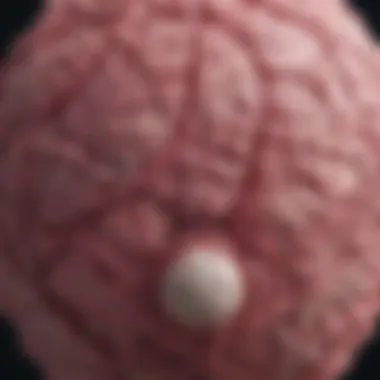
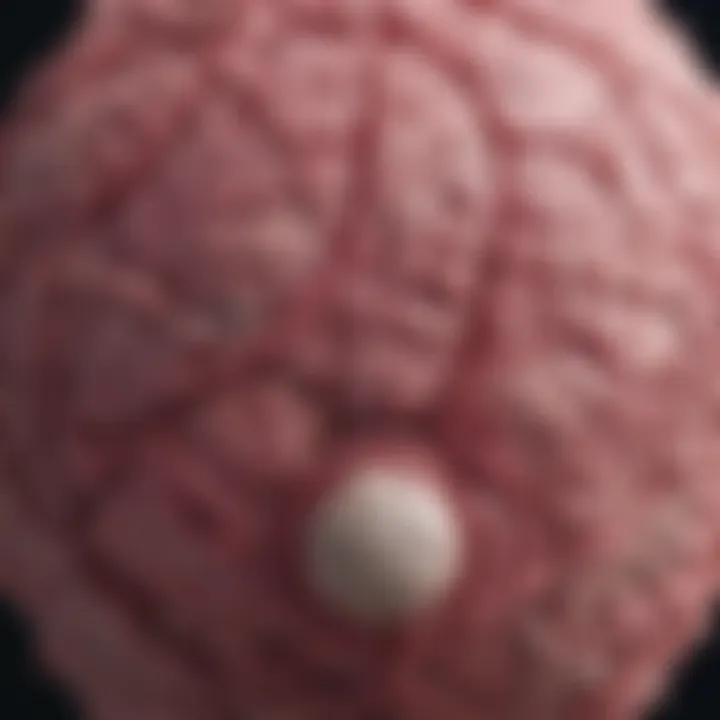
Moreover, the correlation between certain genetic profiles and tumor behavior can offer insights into prognostic factors. These molecular studies are fundamental in establishing both a clearer understanding of oncocytic renal neoplasms and pioneering future research directions.
Emerging Therapeutic Approaches
The exploration of therapeutic alternatives for oncocytic renal neoplasms is gaining momentum. One of the primary focuses is on immunotherapy, which harnesses the body’s own immune system to fight cancer. Innovations in immune checkpoint inhibitors, such as pembrolizumab and nivolumab, show promise for treating various renal tumors, including those with oncocytic characteristics.
Targeted therapies are also under investigation, aiming to block specific molecular targets. For example, agents that focus on the vascular endothelial growth factor (VEGF) pathway are considered in developing treatment protocols. These advancements hold great potential for improving outcomes in patients who do not respond well to traditional surgical methods.
Furthermore, clinical trials evaluating the effectiveness of these innovative therapies are crucial. Engaging in ongoing research not only contributes to knowledge but also enables drawing comparisons between different treatment options and their impacts on oncocytic tumors.
Understanding current research trends in oncocytic renal neoplasms fosters an environment for clinical innovation and improved patient care.
Understanding current research trends in oncocytic renal neoplasms fosters an environment for clinical innovation and improved patient care.
In summary, research is vital for advancing knowledge and therapeutic strategies concerning oncocytic renal neoplasms. Genetic studies lay the groundwork for understanding tumor biology, while emerging therapeutic options provide hope for enhanced patient outcomes.
Challenges in Diagnosis and Treatment
In the context of oncocytic renal neoplasms, understanding the challenges in diagnosis and treatment can greatly influence patient outcomes. These tumors often present unique histopathological features, which can lead to misinterpretation. Moreover, the complexity of oncocytic tumors creates significant hurdles in establishing an effective treatment protocol. Addressing these challenges is critical, as it can enhance the accuracy of diagnosis and improve the strategies employed for management.
Misdiagnosis Issues
Misdiagnosis is a significant problem in managing oncocytic renal neoplasms. Their histological features can overlap with other types of renal tumors, particularly clear cell and papillary renal cell carcinomas. The presence of abundant eosinophilic cytoplasm and peculiar nuclear characteristics can lead to confusion among pathologists. Furthermore, oncocytic tumors can exhibit varying degrees of atypia, complicating the diagnostic process.
The consequences of misdiagnosis are profound. When oncocytic tumors are incorrectly classified as more aggressive forms of renal cancer, patients may undergo unnecessary surgical interventions or aggressive treatments. On the other hand, underestimating the neoplasm's potential can result in inadequate management, increasing the risk of recurrence. Thus, accurate pathological evaluation is pivotal.
The following steps can help mitigate misdiagnosis issues:
- Enhanced training in renal pathology for pathologists
- Use of advanced imaging techniques to differentiate tumor types
- Increased awareness of oncocytic tumor characteristics in clinical practice
"Accurate diagnosis is essential to develop the right treatment plan." - Renowned expert in renal pathology
"Accurate diagnosis is essential to develop the right treatment plan." - Renowned expert in renal pathology
Treatment Resistance
Treatment resistance in oncocytic renal neoplasms poses a major challenge for clinicians. Traditional therapeutic options, including targeted therapies and immunotherapies, may not always produce desired outcomes. The underlying biological mechanisms of oncocytic tumors can contribute to this resistance, potentially due to their unique genetic and molecular characteristics.
Patients often face difficulties in responding to popular therapies such as sunitinib and pazopanib. Research suggests that oncocytic renal neoplasms may have distinct alterations in signaling pathways that may limit the efficacy of these drugs. Furthermore, the microenvironment of oncocytic tumors can provide additional barriers to successful treatment.
As the field advances, understanding treatment resistance mechanisms is critical. Ongoing research into genetic profiling of oncocytic renal neoplasms may offer insight into tailored therapeutic approaches. Efforts to discover biomarkers predictive of treatment response could significantly improve management strategies.
In summary, both misdiagnosis issues and treatment resistance form integral challenges within the landscape of oncocytic renal neoplasms. Recognizing and addressing these complexities can foster improved clinical outcomes.
Comparative Analysis with Other Renal Neoplasms
Understanding oncocytic renal neoplasms necessitates a comparative analysis with other types of renal tumors. This approach provides a framework for distinguishing oncocytic tumors based on their histological, clinical, and prognostic features. The importance of such a comparative perspective lies not only in identifying key differences but also in enhancing diagnostic accuracy and informing treatment decisions. By positioning oncocytic renal neoplasms in relation to more common types, such as clear cell carcinoma and papillary renal cell carcinoma, we establish a clearer context for clinicians and researchers alike.
Clear Cell Carcinoma vs. Oncocytic Tumors
Clear cell carcinoma is the most prevalent subtype of renal cell carcinoma and is characterized by its unique histological appearance. It typically shows a clear cytoplasm due to the accumulation of glycogen and lipids. In contrast, oncocytic tumors display a distinct eosinophilic cytoplasm, which results from abundant mitochondria. This fundamental histological difference is critical during diagnosis.
Clinically, clear cell carcinoma often corresponds with more aggressive features. It has higher rates of metastasis and poorer overall prognosis compared to oncocytic tumors, which tend to show less aggressive behavior in many cases. However, the challenge arises when distinguishing these tumor types based solely on imaging, as both can appear similarly in scans, leading to potential misdiagnosis.
It is essential for pathologists to utilize a combination of histological examination and immunohistochemical markers to successfully differentiate between these neoplasms.
It is essential for pathologists to utilize a combination of histological examination and immunohistochemical markers to successfully differentiate between these neoplasms.
Key differences between clear cell carcinoma and oncocytic tumors include:
- Cytoplasmic Characteristics: Clear cell carcinoma has clear cytoplasm, whereas oncocytic tumors exhibit eosinophilic cytoplasm.
- Prognostic Outcomes: Oncocytic tumors generally have a more favorable prognosis compared to clear cell carcinoma.
Papillary Renal Cell Carcinoma and Its Differences
Papillary renal cell carcinoma, another significant subtype, also presents unique challenges in differentiation from oncocytic tumors. This subtype demonstrates a papillary architecture, which is distinctly different from the oncocytic growth pattern. Histologically, papillary carcinoma contains foamy macrophages, which are usually absent in oncocytic tumors.
In terms of clinical presentation, both oncocytic and papillary tumors can manifest similarly, making assessment based on imaging and even initial biopsy results challenging. However, papillary renal cell carcinoma is noted for having a multifocal nature, meaning it is more likely to occur in multiple locations within the kidney, a factor that aids in differentiating it from oncocytic neoplasms.
Differential characteristics to consider include:
- Histological Architecture: The papillary configuration with foamy macrophages for papillary renal cell carcinoma versus the nested or solid patterns often seen in oncocytic tumors.
- Development Patterns: Multifocality is more common in papillary types, while oncocytic tumors tend to be solitary.
By performing a comparative analysis of oncocytic renal neoplasms against clear cell and papillary renal cell carcinomas, we can not only refine diagnostic methods but also improve treatment approaches. The understanding of these distinctions is crucial for clinicians as they navigate through the complexities of renal neoplasms.
The Role of Pathologists
The role of pathologists in the diagnosis and management of oncocytic renal neoplasms is critical. Pathologists are medical doctors who specialize in diagnosing diseases by examining tissues, cells, and organs. Their expertise is vital for accurate diagnosis, which can significantly influence treatment strategies and patient outcomes.
Pathological Diagnosis Guidelines
Pathologists follow specific guidelines when diagnosing oncocytic renal neoplasms. These guidelines usually encompass:
- Histological Examination: Analyzing tissue samples under a microscope is the cornerstone of diagnosis. Pathologists look for characteristic histological features, such as the distinctive granular cytoplasm seen in oncocytic cells.
- Immunohistochemical Staining: Use of specific antibodies can help differentiate oncocytic tumors from other renal neoplasms. For example, markers like CD10 and RCC antigen are often evaluated.
- Genetic Testing: Certain genetic mutations can provide additional context about tumor behavior. Pathologists may request targeted genetic assessments to inform prognosis and therapy options.
These steps ensure that oncocytic tumors are accurately identified and categorized, enhancing treatment planning.
Collaboration with Clinicians
Effective collaboration between pathologists and clinicians is paramount in managing oncocytic renal neoplasms. Clinicians rely on pathologists for timely and accurate pathology reports to make informed decisions about patient care. The key aspects of this collaboration include:
- Multidisciplinary Tumor Boards: Regular meetings often involve pathologists, surgeons, and oncologists, allowing for a comprehensive discussion of individual cases. This collaboration enhances understanding and alignment on treatment strategies.
- Communication: Clear and ongoing communication regarding pathological findings is crucial. Pathologists must convey their insights on the tumor's grade, stage, and potential biomarkers that can guide therapy.
- Education and Training: Pathologists also play a significant role in educating clinicians about the nuances of oncocytic renal neoplasms. By sharing recent developments in pathology, they help foster a more knowledgeable healthcare team that can better serve patients.
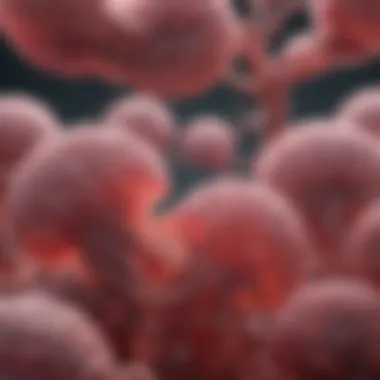

"The collaboration between pathologists and clinicians is essential to advance personalized medicine in treating oncocytic renal neoplasms."
"The collaboration between pathologists and clinicians is essential to advance personalized medicine in treating oncocytic renal neoplasms."
When pathologists and clinicians work together, the quality of patient care improves. They ensure that treatment is based on precise diagnoses, ultimately leading to better long-term outcomes for patients with oncocytic renal neoplasms.
Long-term Outcomes and Follow-up
Understanding the long-term outcomes and the necessity for follow-up in oncocytic renal neoplasms is essential for both patients and clinicians. Oncocytic tumors, while often displaying indolent characteristics, can still pose significant risks if not closely monitored after initial treatment. Continuous assessments can help in timely interventions, improving overall patient management and ensuring optimal health outcomes.
In relation to oncocytic renal neoplasms, long-term follow-up is characterized by routine medical evaluations and imaging studies aimed at detecting any recurrence or progression of the disease. Such follow-up has several benefits, including the ability to identify asymptomatic cases early and to initiate treatment quickly when needed. Regular monitoring helps ease patient anxiety by providing reassurance that their health is being managed effectively.
Survival Rates
Survival rates for patients diagnosed with oncocytic renal neoplasms vary depending on multiple factors, such as tumor size, stage at diagnosis, and the patient's overall health at the time of treatment. Generally, studies indicate favorable survival outcomes, particularly when these tumors are detected at an early stage. The 5-year survival rate reflects the proportion of patients who live at least that long after their diagnosis. For oncocytic renal neoplasm, many sources report rates exceeding 80%, attributing this resilience to less aggressive tumor behavior compared to other renal neoplasms.
It's essential to analyze survival rates within specific subgroups of patients. Age, gender, and underlying health conditions also play a significant role in overall prognosis. Therefore, personalized assessments are critical for accurately estimating individual risks and developing targeted surveillance strategies.
Recurrence Rates
The recurrence rate for oncocytic renal neoplasms can provide valuable insight into long-term monitoring strategies. Research suggests that while the majority of diagnosed cases remain stable after treatment, a subset of patients exhibits recurrence. The recurrence rates can range significantly, often cited between 5% to 25%, depending on factors such as the initial tumor characteristics and compliance with follow-up protocols.
Identification of recurrent disease is crucial, as it may require different management strategies compared to the primary diagnosis. Regular imaging and clinical evaluations not only allow for early detection but also foster a supportive space for patients to discuss concerns about recurrence. This approach is particularly beneficial in managing patient expectations and tailoring future treatment avenues.
Understanding both survival and recurrence rates aids in shaping follow-up strategies, thus enhancing the quality of care in oncocytic renal neoplasm management.
Understanding both survival and recurrence rates aids in shaping follow-up strategies, thus enhancing the quality of care in oncocytic renal neoplasm management.
Cultural and Social Considerations
Cultural and social factors greatly influence the understanding and management of oncocytic renal neoplasms. Awareness around this topic can significantly impact patient outcomes. While oncocytic tumors are less common than other renal neoplasms, their unique characteristics still require attention from medical communities and societies.
Awareness Campaigns
Awareness campaigns play a crucial role in educating both the public and healthcare professionals about oncocytic renal neoplasms. These campaigns aim to reduce stigma and increase understanding regarding kidney-related health issues. Common elements include:
- Educational Materials: Distributing pamphlets, brochures, or digital content that provide essential information about oncocytic tumors, including symptoms, risk factors, and the importance of early diagnosis.
- Public Initiatives: Organizing events such as health fairs where screening for renal neoplasms is offered. This can help in early detection and subsequently improved survival rates.
- Online Platforms: Utilizing websites like Wikipedia and social media to spread knowledge. These platforms can facilitate discussions and share personal stories.
Emerging strategies include leveraging social media platforms like Facebook to connect with broader audiences, creating impactful messages that resonate.
Patient Support Groups
Patient support groups are essential for individuals affected by oncocytic renal neoplasms and their families. These groups provide a safe space for sharing experiences and support, which fosters emotional healing. The major benefits include:
- Community Building: Patients often feel isolated. Support groups help create a sense of belonging and community, alleviating feelings of loneliness.
- Information Exchange: Members can share information about treatment options and connect with healthcare professionals. This exchange enhances patients' understanding of their condition.
- Emotional Support: The psychological burden of cancer can be profound. Support groups offer emotional assistance, allowing patients to share their fears and concerns with those who understand.
"Education is essential. It is every individual's right to have knowledge about their condition and the best ways to manage it."
"Education is essential. It is every individual's right to have knowledge about their condition and the best ways to manage it."
Future Directions in Oncocytic Neoplasm Research
The field of oncocytic renal neoplasms is evolving, and ongoing research is critical for the advancement of knowledge and clinical practice. It is essential to understand the future directions in this area, as they can significantly impact diagnosis, treatment options, and patient outcomes. Research can shed light on the unique biological characteristics of oncocytic tumors, paving the way for more personalized approaches to patient care.
Integrative Approaches
Integrative approaches refer to the combination of multiple scientific disciplines to enhance understanding and treatment. This includes collaborations among pathologists, oncologists, and molecular biologists. New technologies, such as genomics and proteomics, provide insights into the molecular underpinnings of oncocytic renal neoplasms.
- Genomic Profiling: Understanding gene mutations and expression patterns can help identify targeted therapies.
- Microenvironment Studies: Assessing the tumor microenvironment highlights interactions between oncocytic cells and surrounding tissues.
These integrative methods can assist in developing comprehensive treatment strategies that are more effective than traditional methods. For example, combining immunotherapy with molecularly-targeted drugs might enhance efficacy in treating these tumors.
Potential for Novel Treatments
As research progresses, there is potential for developing novel treatments for oncocytic renal neoplasms. Currently, treatment options are limited, and many patients do not respond well to existing therapies. Identifying new drug candidates and treatment modalities can lead to significant improvements.
- Targeted Therapies: With advancements in understanding the genetic landscape of these tumors, new targeted therapies that focus on specific genetic abnormalities can be developed. This could improve patient responses and decreased side effects.
- Combination Therapy: Exploring combinations of existing drugs can lead to synergistic effects, providing better outcomes for patients.
"The future lies in understanding the cancer on a molecular level and tailoring treatments accordingly."
"The future lies in understanding the cancer on a molecular level and tailoring treatments accordingly."
Emerging research also supports the idea of utilizing pharmacogenomics to predict which patients will benefit most from certain treatments. This individualized approach allows for more precise and efficient healthcare delivery, ultimately improving the quality of life for patients with oncocytic renal neoplasms.
In summary, future research in oncocytic neoplasms must focus on integrative approaches and novel treatments to improve diagnostic accuracy and therapeutic efficacy. By fostering collaboration among various scientific communities, it may be possible to unlock the potential of personalized medicine, which could revolutionize the management of these complex tumors.
Culmination and Implications for Practice
Oncocytic renal neoplasm is an important topic within the field of renal pathology. Understanding its characteristics, diagnosis, and treatment options is crucial for both clinicians and researchers. This conclusion aims to synthesize the findings and offer insights into how these insights can influence clinical practices.
The study of oncocytic renal tumors sheds light on the biological behavior of such neoplasms, which often overlaps with other renal cancers. Knowledge of these tumors enhances the diagnostic accuracy and may prevent misdiagnoses. Clinicians must be aware of the distinctive histological features and clinical presentations unique to oncocytic tumors to provide appropriate patient management.
Adopting a multidisciplinary approach that integrates pathology, radiology, and oncology is critical. This cooperation fosters a coherent treatment plan, which ultimately benefits patient outcomes. Moreover, understanding current trends in research offers the potential to incorporate novel therapies into clinical practice, making the management of oncocytic renal neoplasms more effective.
"Continuous research and collaboration can lead to improved diagnostics and tailored therapies for oncocytic renal neoplasms."
"Continuous research and collaboration can lead to improved diagnostics and tailored therapies for oncocytic renal neoplasms."
Summary of Key Points
In summary, several key points emerge from the exploration of oncocytic renal neoplasms:
- Definition and Classification: Oncocytic tumors are defined by their distinctive histological features, setting them apart from other renal neoplasms.
- Clinical Relevance: Accurate diagnosis is paramount to ensure proper management, as symptoms may mimic other types of renal tumors.
- Prognosis: Understanding the prognostic factors is essential for predicting patient outcomes and tailoring treatment options.
- Research Trends: Ongoing studies in molecular biology and genetics offer new avenues for potential treatments and better understanding of tumor behavior.
Recommendations for Clinicians
For clinicians dealing with oncocytic renal neoplasms, several recommendations can enhance patient care:
- Educate on Diagnostic Features: Regular training on the histopathological features of oncocytic tumors should be implemented to improve diagnostic accuracy.
- Multidisciplinary Collaboration: Foster relationships with pathologists and radiologists to create comprehensive treatment protocols that address all aspects of patient care.
- Stay Updated on Research: Keep abreast of the latest research regarding oncocytic tumors, especially emerging therapeutic options that may become available.
- Patient Education: Engage with patients regarding their diagnosis and treatment options, as informed patients tend to have better outcomes and satisfaction with care.



